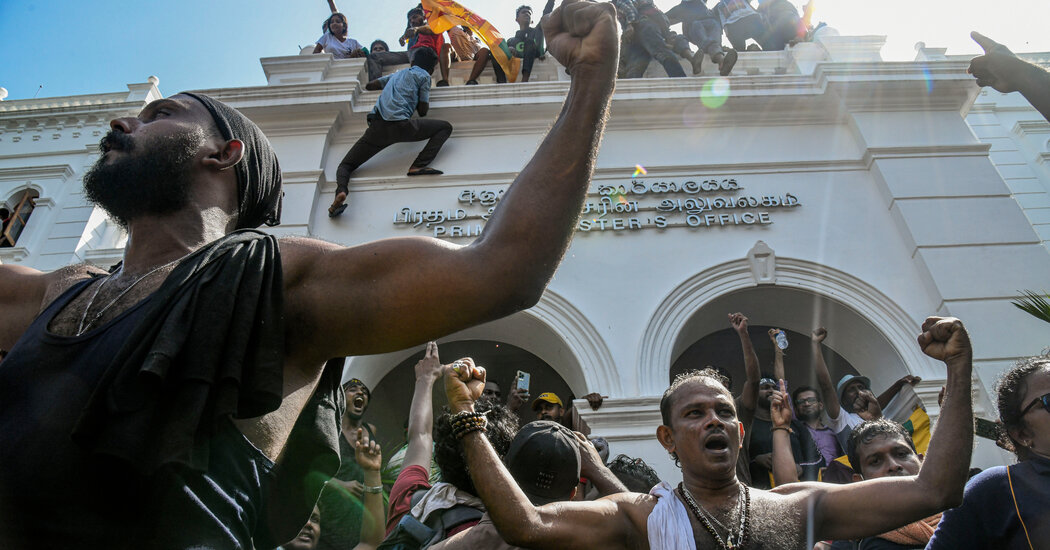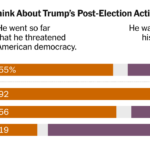
COLOMBO, Sri Lanka — Sri Lanka descended into political chaos Wednesday, as the unpopular president fled the country and protesters overran the interim leader’s offices, leaving it unclear who held power or how long it would last.
Mass demonstrations and tear gas filled the streets of Colombo, the capital, and late into the night, protesters clashed with the police outside Parliament, the only top government compound that had not been occupied. The Bar Association of Sri Lanka, a supporter of the protest movement, warned of “a situation of lawlessness and anarchy.”
Months of largely peaceful protest and power struggles have moved the country no closer to addressing the root cause of popular fury: a crashed economy that has brought fuel shortages, rising food prices and widespread misery.
It is also unclear whether the departure of President Gotabaya Rajapaksa was a lasting step toward demonstrators’ goal of breaking his family’s hold on power.
The day began with a bombshell: Mr. Rajapaksa had left the island nation before dawn on a military aircraft to the Maldives. Over the weekend, tens of thousands — if not hundreds of thousands — of protesters had stormed his offices and residence, and he had gone into hiding.
“The thieves are running away,” said Sanjayra Perera, a university librarian who was among the thousands of protesters who traveled to Colombo, along with her two young children.
To the demonstrators, it felt like victory, confirmation of statements by government officials that both the president and the equally unpopular prime minister, Ranil Wickremesinghe, would step down. But tensions grew amid confusion over Mr. Rajapaksa’s status, and just who was in charge.
As the day wore on, it emerged that the old guard was trying to cling to power. Mr. Rajapaksa had left but not resigned. His ally Mahinda Yapa Abeywardena, the Parliament speaker, read a statement on behalf of the president saying that Mr. Rajapaksa had appointed Mr. Wickremesinghe as acting president “while the president is overseas.”
Understand What Is Happening in Sri Lanka
A president ousted. Sri Lanka plunged into a deep crisis when protestors, pushing for the resignation of President Gotabaya Rajapaksa, stormed his residence, pushing him to flee the country. Here is what to know:
Even after fleeing, Mr. Rajapaksa, 73, was not committing to ending his presidency. Instead, he was leaving as caretaker someone they despised, who had been expected to leave office as well.
A massive crowd marched on Mr. Wickremesinghe’s offices, demanding that he step down. After a standoff that involved the security forces firing constant rounds of tear gas, protesters overran the compound.
“The whole country has rejected him,” Shameen Opanayke, a 22-year-old with his sisters and mother at the protest in Colombo, said of the president.
Of the acting president, Mr. Wickremesinghe, he said “nobody wants him either.”
In a televised address, Mr. Wickremesinghe declared a state of emergency and asked the security forces to retake the overrun government buildings.
“We have to rid this country of this fascist threat,” he said, referring to elements among the protesters.
But as a sign of the depth of the confusion, it was not clear whether the security chiefs were following his orders. There was little sign of efforts to clear the streets or retake the buildings, and the generals made no mention of the acting president or the state of emergency in their own televised statement to the nation that followed.
The crisis comes just when Sri Lanka needs to project stability to secure badly needed international financial help. The country is out of foreign currency reserves, lacking money for crucial imports. It has defaulted on its massive foreign debt, and it has exhausted immediate sources of assistance.
In recent months, it has been running mostly on aid from partners like India, which has doled out about $4 billion. But a crisis of government, with disputed leadership and streets run by protesters, makes the work of diplomacy — including negotiations with organizations such as the International Monetary Fund to restructure the country’s debt — nearly impossible.
Some of Mr. Wickremesinghe’s allies have made the case that he was only staying on to avoid a complete collapse of government. Sri Lankan law stipulates that the resignation of a prime minister not only disbands the cabinet of ministers, but also relieves the ministerial secretaries — the highest-ranking bureaucrats.
Eran Wickramaratne, an opposition lawmaker, said whoever takes the reins of government will have a difficult time, and ultimately will need to call elections for a new mandate, so that the protest movement and the political process can have an opportunity to converge. The immediate task, though, is ensuring supplies of fuel, food and medicine for the next six months, to create breathing room for medium- and long-term corrections of economic policies.
“The focus needs to be easing the burden that people are facing immediately,” he said.
The Rajapaksa family has dominated Sri Lankan politics for almost two decades, dogged by repeated claims of corruption. The current president’s older brother, Mahinda Rajapaksa, also served as president, ending the country’s long civil war in 2009 through brutal use of military force, leading to allegations of severe human rights abuses.
After Gotabaya Rajapaksa was elected president in 2019, he made Mahinda prime minister — his third stint in that post — and two other brothers headed government ministries. The president’s brothers have all stepped down in recent months.
Opposition leaders made clear Wednesday that they would not accept Mr. Wickremesinghe, 73, as acting president, pointing to his lack of popular or parliamentary support. They want to quickly move to the process of succession prescribed by the constitution in the case of a president’s resignation: that Parliament holds a vote for the top job from among the lawmakers.
Mr. Wickremesinghe has served several times as prime minister over the last three decades, but his return to the post in May, after protests forced out Mahinda Rajapaksa, was seen as a nearly miraculous political comeback.
Just three years ago, he lost the majority support of his party in a bitter split, and what remained of the party failed to win even a single seat in the 2020 parliamentary elections. Mr. Wickremesignhe essentially found a back door into Parliament by occupying one of two dozen seats that are appointed and not elected.
President Rajapaksa appointed him prime minister with the backing of his own party, which has a majority in Parliament, in hopes that his experience dealing with international donors could shore up assistance to revive the economy and ease the pressure on his government.
“A member of Parliament with one seat is appointed as prime minister, now the same person is appointed as acting President,” Sajith Premadasa, the leader of the opposition, said on Twitter. “This is the Rajapaksa style of democracy. What a farce. What a tragedy.”




